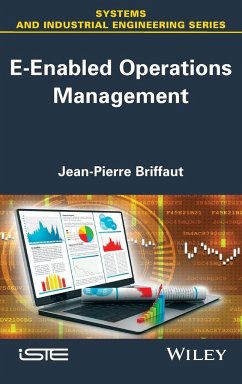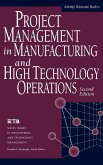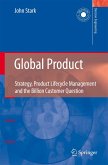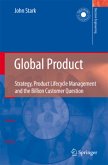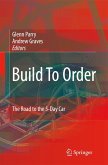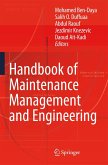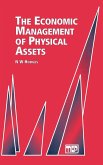Jean-Pierre Briffaut
E-Enabled Operations Management
Jean-Pierre Briffaut
E-Enabled Operations Management
- Gebundenes Buch
- Merkliste
- Auf die Merkliste
- Bewerten Bewerten
- Teilen
- Produkt teilen
- Produkterinnerung
- Produkterinnerung
Although the theory of operations management has been presented in many textbooks published in the last two decades, the subject of e-enabled operations management is rather short of easily accessible literature. The approach to operations management described in this book is unusual with respect to what is found in standard textbooks. Information and Communication Technologies (ICT) impact the ways firms are organised and managed, and as a consequence change the practical means used to conduct business operations. The features of this book are threefold. System approach to business modelling:…mehr
Andere Kunden interessierten sich auch für
![Project Management in Manufacturing and High Technology Operations Project Management in Manufacturing and High Technology Operations]() Adedeji Bodunde BadiruProject Management in Manufacturing and High Technology Operations207,99 €
Adedeji Bodunde BadiruProject Management in Manufacturing and High Technology Operations207,99 €![Global Product Global Product]() John StarkGlobal Product77,99 €
John StarkGlobal Product77,99 €![Global Product Global Product]() John StarkGlobal Product94,99 €
John StarkGlobal Product94,99 €![Reliability and Six Sigma Reliability and Six Sigma]() U. Dinesh KumarReliability and Six Sigma85,99 €
U. Dinesh KumarReliability and Six Sigma85,99 €![Build to Order Build to Order]() Glenn Parry / Andrew Graves (eds.)Build to Order77,99 €
Glenn Parry / Andrew Graves (eds.)Build to Order77,99 €![Handbook of Maintenance Management and Engineering Handbook of Maintenance Management and Engineering]() Mohamed Ben-Daya / Salih O. Duffuaa / Abdul Raouf / Jezdimir Knezevic / Daoud Ait-Kadi (ed.)Handbook of Maintenance Management and Engineering419,99 €
Mohamed Ben-Daya / Salih O. Duffuaa / Abdul Raouf / Jezdimir Knezevic / Daoud Ait-Kadi (ed.)Handbook of Maintenance Management and Engineering419,99 €![Economic Management of Physical Assets Economic Management of Physical Assets]() N W HodgesEconomic Management of Physical Assets173,99 €
N W HodgesEconomic Management of Physical Assets173,99 €-
-
-
Although the theory of operations management has been presented in many textbooks published in the last two decades, the subject of e-enabled operations management is rather short of easily accessible literature. The approach to operations management described in this book is unusual with respect to what is found in standard textbooks. Information and Communication Technologies (ICT) impact the ways firms are organised and managed, and as a consequence change the practical means used to conduct business operations. The features of this book are threefold. System approach to business modelling: Business activities, controlling functions and associated information systems are described within a coherent analytical system framework allowing a clear understanding of the various current control and costing concepts. Operations costing is not usually included in textbooks as part of operations management, but it should be. Cost targeting has become an integral part of good practice of business management. Validity of models: Apparently simple models are analyzed in depth. Students must be fully aware of the assumptions made when models are formulated and of their conditions of validity. Applying a model implies automatically that assumptions of a sort are taken for granted. Logistics, procurement and quality management: These three business functions are critical key success factors for managing e-enabled supply chains from suppliers to customers. That is why their main tools are introduced in this document.
Hinweis: Dieser Artikel kann nur an eine deutsche Lieferadresse ausgeliefert werden.
Hinweis: Dieser Artikel kann nur an eine deutsche Lieferadresse ausgeliefert werden.
Produktdetails
- Produktdetails
- Verlag: Wiley
- Seitenzahl: 284
- Erscheinungstermin: 3. August 2015
- Englisch
- Abmessung: 240mm x 161mm x 20mm
- Gewicht: 607g
- ISBN-13: 9781848218406
- ISBN-10: 1848218400
- Artikelnr.: 42602904
- Herstellerkennzeichnung
- Libri GmbH
- Europaallee 1
- 36244 Bad Hersfeld
- gpsr@libri.de
- Verlag: Wiley
- Seitenzahl: 284
- Erscheinungstermin: 3. August 2015
- Englisch
- Abmessung: 240mm x 161mm x 20mm
- Gewicht: 607g
- ISBN-13: 9781848218406
- ISBN-10: 1848218400
- Artikelnr.: 42602904
- Herstellerkennzeichnung
- Libri GmbH
- Europaallee 1
- 36244 Bad Hersfeld
- gpsr@libri.de
Jean-Pierre Briffaut, is the author of E-Enabled Operations Management, published by Wiley.
PREFACE xiii
PART 1. MODELING OF BUSINESS STRUCTURES 1
CHAPTER 1. SYSTEM APPROACH TO BUSINESS OPERATIONS AND INFORMATION
ENGINEERING 3
1.1. System approach to conduct business operations 3
1.1.1. General considerations 3
1.1.2. System description 4
1.2. Information engineering 6
1.2.1. Information as a resource 6
1.2.2. Explicit and implicit information 6
1.2.3. Clarification of some terms 7
1.2.4. Characteristics of information systems 7
1.2.5. Information system content for a manufacturing company 8
1.3. System approach to describing inventory-controlled storage 8
CHAPTER 2. BUSINESS MODELING BY PROCESS AND MANAGEMENT APPLICATIONS 13
2.1. Process definition and control 13
2.1.1. Definition 13
2.1.2. Process control mechanisms 14
2.2. Process modeling in perspective 15
2.2.1. General considerations 15
2.2.2. Management applications 17
2.3. Management by process 19
2.3.1. Activity-based costing and budgeting of products/services 20
2.3.2. Activity-based management 28
2.3.3. Information system: relationships between processes, activities and
data 30
CHAPTER 3. BUSINESS MODELS: CONTROL MODELS, FLOW MODELS, ORGANIZATION
MODELS, FUNCTION MODELS 33
3.1. Organizational structure as a blueprint for information systems 33
3.2. Business models 36
3.2.1. Definitions 36
3.2.2. Examples of business models 38
3.2.3. Example of business function model 39
3.2.4. Examples of business flow model 40
3.3. Aris-toolset: a software-toolset: a software package for business
modeling 43
3.3.1. Introduction 43
3.3.2. Logic connectors in event-driven processes 45
3.3.3. Exercises 46
3.4. Supply-chain operations reference modeling 49
3.4.1. Introduction 49
3.4.2. What is a process reference model? 50
3.4.3. Model scope and structure 52
3.4.4. Applying the reference model to configurability 54
PART 2. MANAGERIAL CONCEPTS AND SOFTWARE PACKAGES IN PERSPECTIVE 57
CHAPTER 4. FROM MATERIALS REQUIREMENT PLANNING (MRP) TO ENTERPRISE RESOURCE
PLANNING (ERP) CONCEPTS AND THE ASSOCIATED SOFTWARE PACKAGES (PICS AND
COPICS OF IBM TO ERP-LABELED PACKAGES) 59
4.1. From MRP to ERP concepts 59
4.1.1. Overview of the evolution of management thinking 59
4.1.2. Correlation between management thinking and DBMS 63
4.1.3. Styles of manufacturing 64
4.2. Inventory control system 65
4.2.1. Basic model: reorder quantity 65
4.2.2. Basic model: lead time and threshold stock 67
4.2.3. Generalization of the basic model 68
4.2.4. Probabilistic situation: service levels and safety stock 69
4.2.5. Delivering into stock over time: economic manufacturing quantity
(EMQ) 72
4.3. Manufacturing resource planning 76
4.3.1. Defining planning and scheduling 76
4.3.2. General description of the MRP technique 76
4.3.3. MRP-related concepts in action 80
4.3.4. Implementation of MRP-related concepts in the maintenance field 88
4.4. The just-in-time concept 93
4.4.1. Introduction 93
4.4.2. Core features of the just-in-time concept 94
4.4.3. JIT and inventory management 96
4.4.4. JIT and resources capacities 97
4.4.5. JIT and kanban 99
4.5. Customer order decoupling point 102
4.5.1. Description 102
4.5.2. Deploying an MPS within a CODP context 103
4.6. Contrasting the various control concepts 104
CHAPTER 5. SPECIFIC FEATURES OF ERP PACKAGES 107
5.1. Featuring ERP philosophy of software packages 107
5.2. ERP-tagged software packages for managing business processes available
in the marketplace 108
5.3. Function capabilities of the SAP CRM package 108
5.3.1. Why CRM? 108
5.3.2. Function capabilities of CRM software systems 110
5.4. Reference control model of a manufacturing firm 111
5.5. Finance reference control model 120
PART 3. BEYOND ERP PACKAGES: THE E-ENABLED ENTERPRISE 123
CHAPTER 6. CHANGE IN BUSINESS PROCESSES INDUCED BY E-COMMERCE AND
E-BUSINESS 125
6.1. General considerations for approaching the digital economy 125
6.2. Change in business structures 127
6.3. Microeconomic approach to the digital economy 130
6.4. E-commerce 132
6.4.1. Distinction between e-commerce and e-business 132
6.4.2. E-commerce from different perspectives 133
6.4.3. Business models for e-commerce exchanges 135
6.5. Changes in business processes induced by e-enabled business operations
135
6.5.1. Dell business model and its evolution 136
6.5.2. Bricks-and-mortar model 138
6.5.3. Virtual firm model 139
6.6. Online auction process 140
6.6.1. Introduction 140
6.6.2. Online auction process in a high-tech manufacturing company 140
6.6.3. Description of the market place COVISINT 143
6.6.4. Exercise 144
6.7. E-commerce, sales chains and ROI 149
6.7.1. General setting 149
6.7.2. ROI of e-commerce in sales chains 152
CHAPTER 7. CONTROL PARAMETERS FOR E-ENABLED SUPPLY CHAIN 155
7.1. Collaborative planning, forecasting and replenishment 155
7.2. Control parameters for e-enabled supply chain 157
7.2.1. Master production schedule 158
7.2.2. Projected available balance (PAB) 159
7.2.3. Available to promise (ATP) 159
7.3. The bullwhip effect 160
7.3.1. The model 161
CHAPTER 8. INTEGRATION OF ERP PROCESSES WITH E-COMMERCE AND E-BUSINESS
PATTERNS 163
8.1. Information system architecture and business processes 163
8.1.1. What is a layer architecture? 163
8.1.2. What is a layer architecture describing a business? 164
8.1.3. Developing a layer architecture 165
8.1.4. Relations between different layers 166
8.1.5. Relations between different subsystems inside a layer 167
8.2. Business workflows and information system architecture 168
8.3. Integration of ERP processes with e-commerce and e-business 169
CHAPTER 9. ROLES OF INFORMATION TECHNOLOGIES FOR MAKING BUSINESS MODELS
FLEXIBLE 175
9.1. Information technologies: engine of change 175
9.1.1. CAD/CAM 176
9.1.2. Quality of service and speed of delivery 176
9.1.3. Virtual organizations 176
9.2. Approach to the specific functions of virtual collaborative context
177
9.3. Applications of portals 181
9.3.1. How portals impact business organizations 181
9.3.2. Portals and negotiations in business life 181
9.3.3. Scenario of a collaborative e-enabled working environment in the
fashion-sensitive textile sector 184
9.3.4. Example of a collaborative design environment 191
9.3.5. Benefits of electronic negotiations 193
PART 4. CRITICAL BUSINESS FUNCTIONS FOR E-ENABLED OPERATIONS MANAGEMENT 197
CHAPTER 10. LOGISTICS 199
10.1. Logistics in perspective 199
10.1.1. Overview 199
10.1.2. Components of logistics 200
10.1.3. Logistics and the digital economy 201
10.2. Logistics and hierarchical layers of management within the framework
of supply chain management 203
10.2.1. General context 203
10.2.2. Promotion of logistics strategy by Toshiba of Japan 205
10.3. Information system for e-logistics 206
10.3.1. Introduction 206
10.3.2. Goods movement control system and its components from the customer
side 208
10.3.3. Goods movement control system and its components from the
provisioning side 211
10.3.4. Electronic data interchange 214
10.4. Logistics flow process management: logistics performance indicators
224
10.4.1. Definition 224
10.4.2. Logistics key indicators 224
10.4.3. Definitions of logistics key indicators 226
10.5. Location analysis of warehouses and transportation 227
10.5.1. Transportation method 228
10.5.2. Procedure of the transportation method 229
10.5.3. Stepping-stone method 229
10.5.4. VAM method 230
10.5.5. Problem setting 231
10.5.6. Solution with the northwest corner rule and the stepping-stone
method 232
10.6. Reverse logistics: cash from trash and environmental issues 235
CHAPTER 11. SOURCING AND PHYSICAL DISTRIBUTION 237
11.1. Sourcing policy 237
11.1.1. Pure market option 237
11.1.2. Controlled competition option 238
11.1.3. Vertical integration option 238
11.1.4. Advantages versus disadvantages of the various options in relation
to business strategy and types of products 239
11.2. Physical distribution policy 243
11.2.1. Objectives and constraints 243
11.2.2. Various patterns of physical distribution 244
11.2.3. Choice of a physical distribution option 245
CHAPTER 12. QUANTITATIVE QUALITY MANAGEMENT 247
12.1. ISO 9000 standards: impact upon business operations 247
12.2. Acceptance testing 248
12.3. Operating characteristic curve 248
12.4. Average outgoing quality 252
12.5. Terms used in an acceptance plan for attributes 255
PART 5. CASE STUDIES 257
CHAPTER 13. CASE STUDIES: HELLAS CORPORATION AND THE E-ENABLED CAR INDUSTRY
259
13.1. Hellas Corporation case study 259
13.2. The e-enabled car industry 263
13.2.1. Introduction 263
13.2.2. Assignment 264
13.2.3. Car manufacturing 264
INDEX 269
PART 1. MODELING OF BUSINESS STRUCTURES 1
CHAPTER 1. SYSTEM APPROACH TO BUSINESS OPERATIONS AND INFORMATION
ENGINEERING 3
1.1. System approach to conduct business operations 3
1.1.1. General considerations 3
1.1.2. System description 4
1.2. Information engineering 6
1.2.1. Information as a resource 6
1.2.2. Explicit and implicit information 6
1.2.3. Clarification of some terms 7
1.2.4. Characteristics of information systems 7
1.2.5. Information system content for a manufacturing company 8
1.3. System approach to describing inventory-controlled storage 8
CHAPTER 2. BUSINESS MODELING BY PROCESS AND MANAGEMENT APPLICATIONS 13
2.1. Process definition and control 13
2.1.1. Definition 13
2.1.2. Process control mechanisms 14
2.2. Process modeling in perspective 15
2.2.1. General considerations 15
2.2.2. Management applications 17
2.3. Management by process 19
2.3.1. Activity-based costing and budgeting of products/services 20
2.3.2. Activity-based management 28
2.3.3. Information system: relationships between processes, activities and
data 30
CHAPTER 3. BUSINESS MODELS: CONTROL MODELS, FLOW MODELS, ORGANIZATION
MODELS, FUNCTION MODELS 33
3.1. Organizational structure as a blueprint for information systems 33
3.2. Business models 36
3.2.1. Definitions 36
3.2.2. Examples of business models 38
3.2.3. Example of business function model 39
3.2.4. Examples of business flow model 40
3.3. Aris-toolset: a software-toolset: a software package for business
modeling 43
3.3.1. Introduction 43
3.3.2. Logic connectors in event-driven processes 45
3.3.3. Exercises 46
3.4. Supply-chain operations reference modeling 49
3.4.1. Introduction 49
3.4.2. What is a process reference model? 50
3.4.3. Model scope and structure 52
3.4.4. Applying the reference model to configurability 54
PART 2. MANAGERIAL CONCEPTS AND SOFTWARE PACKAGES IN PERSPECTIVE 57
CHAPTER 4. FROM MATERIALS REQUIREMENT PLANNING (MRP) TO ENTERPRISE RESOURCE
PLANNING (ERP) CONCEPTS AND THE ASSOCIATED SOFTWARE PACKAGES (PICS AND
COPICS OF IBM TO ERP-LABELED PACKAGES) 59
4.1. From MRP to ERP concepts 59
4.1.1. Overview of the evolution of management thinking 59
4.1.2. Correlation between management thinking and DBMS 63
4.1.3. Styles of manufacturing 64
4.2. Inventory control system 65
4.2.1. Basic model: reorder quantity 65
4.2.2. Basic model: lead time and threshold stock 67
4.2.3. Generalization of the basic model 68
4.2.4. Probabilistic situation: service levels and safety stock 69
4.2.5. Delivering into stock over time: economic manufacturing quantity
(EMQ) 72
4.3. Manufacturing resource planning 76
4.3.1. Defining planning and scheduling 76
4.3.2. General description of the MRP technique 76
4.3.3. MRP-related concepts in action 80
4.3.4. Implementation of MRP-related concepts in the maintenance field 88
4.4. The just-in-time concept 93
4.4.1. Introduction 93
4.4.2. Core features of the just-in-time concept 94
4.4.3. JIT and inventory management 96
4.4.4. JIT and resources capacities 97
4.4.5. JIT and kanban 99
4.5. Customer order decoupling point 102
4.5.1. Description 102
4.5.2. Deploying an MPS within a CODP context 103
4.6. Contrasting the various control concepts 104
CHAPTER 5. SPECIFIC FEATURES OF ERP PACKAGES 107
5.1. Featuring ERP philosophy of software packages 107
5.2. ERP-tagged software packages for managing business processes available
in the marketplace 108
5.3. Function capabilities of the SAP CRM package 108
5.3.1. Why CRM? 108
5.3.2. Function capabilities of CRM software systems 110
5.4. Reference control model of a manufacturing firm 111
5.5. Finance reference control model 120
PART 3. BEYOND ERP PACKAGES: THE E-ENABLED ENTERPRISE 123
CHAPTER 6. CHANGE IN BUSINESS PROCESSES INDUCED BY E-COMMERCE AND
E-BUSINESS 125
6.1. General considerations for approaching the digital economy 125
6.2. Change in business structures 127
6.3. Microeconomic approach to the digital economy 130
6.4. E-commerce 132
6.4.1. Distinction between e-commerce and e-business 132
6.4.2. E-commerce from different perspectives 133
6.4.3. Business models for e-commerce exchanges 135
6.5. Changes in business processes induced by e-enabled business operations
135
6.5.1. Dell business model and its evolution 136
6.5.2. Bricks-and-mortar model 138
6.5.3. Virtual firm model 139
6.6. Online auction process 140
6.6.1. Introduction 140
6.6.2. Online auction process in a high-tech manufacturing company 140
6.6.3. Description of the market place COVISINT 143
6.6.4. Exercise 144
6.7. E-commerce, sales chains and ROI 149
6.7.1. General setting 149
6.7.2. ROI of e-commerce in sales chains 152
CHAPTER 7. CONTROL PARAMETERS FOR E-ENABLED SUPPLY CHAIN 155
7.1. Collaborative planning, forecasting and replenishment 155
7.2. Control parameters for e-enabled supply chain 157
7.2.1. Master production schedule 158
7.2.2. Projected available balance (PAB) 159
7.2.3. Available to promise (ATP) 159
7.3. The bullwhip effect 160
7.3.1. The model 161
CHAPTER 8. INTEGRATION OF ERP PROCESSES WITH E-COMMERCE AND E-BUSINESS
PATTERNS 163
8.1. Information system architecture and business processes 163
8.1.1. What is a layer architecture? 163
8.1.2. What is a layer architecture describing a business? 164
8.1.3. Developing a layer architecture 165
8.1.4. Relations between different layers 166
8.1.5. Relations between different subsystems inside a layer 167
8.2. Business workflows and information system architecture 168
8.3. Integration of ERP processes with e-commerce and e-business 169
CHAPTER 9. ROLES OF INFORMATION TECHNOLOGIES FOR MAKING BUSINESS MODELS
FLEXIBLE 175
9.1. Information technologies: engine of change 175
9.1.1. CAD/CAM 176
9.1.2. Quality of service and speed of delivery 176
9.1.3. Virtual organizations 176
9.2. Approach to the specific functions of virtual collaborative context
177
9.3. Applications of portals 181
9.3.1. How portals impact business organizations 181
9.3.2. Portals and negotiations in business life 181
9.3.3. Scenario of a collaborative e-enabled working environment in the
fashion-sensitive textile sector 184
9.3.4. Example of a collaborative design environment 191
9.3.5. Benefits of electronic negotiations 193
PART 4. CRITICAL BUSINESS FUNCTIONS FOR E-ENABLED OPERATIONS MANAGEMENT 197
CHAPTER 10. LOGISTICS 199
10.1. Logistics in perspective 199
10.1.1. Overview 199
10.1.2. Components of logistics 200
10.1.3. Logistics and the digital economy 201
10.2. Logistics and hierarchical layers of management within the framework
of supply chain management 203
10.2.1. General context 203
10.2.2. Promotion of logistics strategy by Toshiba of Japan 205
10.3. Information system for e-logistics 206
10.3.1. Introduction 206
10.3.2. Goods movement control system and its components from the customer
side 208
10.3.3. Goods movement control system and its components from the
provisioning side 211
10.3.4. Electronic data interchange 214
10.4. Logistics flow process management: logistics performance indicators
224
10.4.1. Definition 224
10.4.2. Logistics key indicators 224
10.4.3. Definitions of logistics key indicators 226
10.5. Location analysis of warehouses and transportation 227
10.5.1. Transportation method 228
10.5.2. Procedure of the transportation method 229
10.5.3. Stepping-stone method 229
10.5.4. VAM method 230
10.5.5. Problem setting 231
10.5.6. Solution with the northwest corner rule and the stepping-stone
method 232
10.6. Reverse logistics: cash from trash and environmental issues 235
CHAPTER 11. SOURCING AND PHYSICAL DISTRIBUTION 237
11.1. Sourcing policy 237
11.1.1. Pure market option 237
11.1.2. Controlled competition option 238
11.1.3. Vertical integration option 238
11.1.4. Advantages versus disadvantages of the various options in relation
to business strategy and types of products 239
11.2. Physical distribution policy 243
11.2.1. Objectives and constraints 243
11.2.2. Various patterns of physical distribution 244
11.2.3. Choice of a physical distribution option 245
CHAPTER 12. QUANTITATIVE QUALITY MANAGEMENT 247
12.1. ISO 9000 standards: impact upon business operations 247
12.2. Acceptance testing 248
12.3. Operating characteristic curve 248
12.4. Average outgoing quality 252
12.5. Terms used in an acceptance plan for attributes 255
PART 5. CASE STUDIES 257
CHAPTER 13. CASE STUDIES: HELLAS CORPORATION AND THE E-ENABLED CAR INDUSTRY
259
13.1. Hellas Corporation case study 259
13.2. The e-enabled car industry 263
13.2.1. Introduction 263
13.2.2. Assignment 264
13.2.3. Car manufacturing 264
INDEX 269
PREFACE xiii
PART 1. MODELING OF BUSINESS STRUCTURES 1
CHAPTER 1. SYSTEM APPROACH TO BUSINESS OPERATIONS AND INFORMATION
ENGINEERING 3
1.1. System approach to conduct business operations 3
1.1.1. General considerations 3
1.1.2. System description 4
1.2. Information engineering 6
1.2.1. Information as a resource 6
1.2.2. Explicit and implicit information 6
1.2.3. Clarification of some terms 7
1.2.4. Characteristics of information systems 7
1.2.5. Information system content for a manufacturing company 8
1.3. System approach to describing inventory-controlled storage 8
CHAPTER 2. BUSINESS MODELING BY PROCESS AND MANAGEMENT APPLICATIONS 13
2.1. Process definition and control 13
2.1.1. Definition 13
2.1.2. Process control mechanisms 14
2.2. Process modeling in perspective 15
2.2.1. General considerations 15
2.2.2. Management applications 17
2.3. Management by process 19
2.3.1. Activity-based costing and budgeting of products/services 20
2.3.2. Activity-based management 28
2.3.3. Information system: relationships between processes, activities and
data 30
CHAPTER 3. BUSINESS MODELS: CONTROL MODELS, FLOW MODELS, ORGANIZATION
MODELS, FUNCTION MODELS 33
3.1. Organizational structure as a blueprint for information systems 33
3.2. Business models 36
3.2.1. Definitions 36
3.2.2. Examples of business models 38
3.2.3. Example of business function model 39
3.2.4. Examples of business flow model 40
3.3. Aris-toolset: a software-toolset: a software package for business
modeling 43
3.3.1. Introduction 43
3.3.2. Logic connectors in event-driven processes 45
3.3.3. Exercises 46
3.4. Supply-chain operations reference modeling 49
3.4.1. Introduction 49
3.4.2. What is a process reference model? 50
3.4.3. Model scope and structure 52
3.4.4. Applying the reference model to configurability 54
PART 2. MANAGERIAL CONCEPTS AND SOFTWARE PACKAGES IN PERSPECTIVE 57
CHAPTER 4. FROM MATERIALS REQUIREMENT PLANNING (MRP) TO ENTERPRISE RESOURCE
PLANNING (ERP) CONCEPTS AND THE ASSOCIATED SOFTWARE PACKAGES (PICS AND
COPICS OF IBM TO ERP-LABELED PACKAGES) 59
4.1. From MRP to ERP concepts 59
4.1.1. Overview of the evolution of management thinking 59
4.1.2. Correlation between management thinking and DBMS 63
4.1.3. Styles of manufacturing 64
4.2. Inventory control system 65
4.2.1. Basic model: reorder quantity 65
4.2.2. Basic model: lead time and threshold stock 67
4.2.3. Generalization of the basic model 68
4.2.4. Probabilistic situation: service levels and safety stock 69
4.2.5. Delivering into stock over time: economic manufacturing quantity
(EMQ) 72
4.3. Manufacturing resource planning 76
4.3.1. Defining planning and scheduling 76
4.3.2. General description of the MRP technique 76
4.3.3. MRP-related concepts in action 80
4.3.4. Implementation of MRP-related concepts in the maintenance field 88
4.4. The just-in-time concept 93
4.4.1. Introduction 93
4.4.2. Core features of the just-in-time concept 94
4.4.3. JIT and inventory management 96
4.4.4. JIT and resources capacities 97
4.4.5. JIT and kanban 99
4.5. Customer order decoupling point 102
4.5.1. Description 102
4.5.2. Deploying an MPS within a CODP context 103
4.6. Contrasting the various control concepts 104
CHAPTER 5. SPECIFIC FEATURES OF ERP PACKAGES 107
5.1. Featuring ERP philosophy of software packages 107
5.2. ERP-tagged software packages for managing business processes available
in the marketplace 108
5.3. Function capabilities of the SAP CRM package 108
5.3.1. Why CRM? 108
5.3.2. Function capabilities of CRM software systems 110
5.4. Reference control model of a manufacturing firm 111
5.5. Finance reference control model 120
PART 3. BEYOND ERP PACKAGES: THE E-ENABLED ENTERPRISE 123
CHAPTER 6. CHANGE IN BUSINESS PROCESSES INDUCED BY E-COMMERCE AND
E-BUSINESS 125
6.1. General considerations for approaching the digital economy 125
6.2. Change in business structures 127
6.3. Microeconomic approach to the digital economy 130
6.4. E-commerce 132
6.4.1. Distinction between e-commerce and e-business 132
6.4.2. E-commerce from different perspectives 133
6.4.3. Business models for e-commerce exchanges 135
6.5. Changes in business processes induced by e-enabled business operations
135
6.5.1. Dell business model and its evolution 136
6.5.2. Bricks-and-mortar model 138
6.5.3. Virtual firm model 139
6.6. Online auction process 140
6.6.1. Introduction 140
6.6.2. Online auction process in a high-tech manufacturing company 140
6.6.3. Description of the market place COVISINT 143
6.6.4. Exercise 144
6.7. E-commerce, sales chains and ROI 149
6.7.1. General setting 149
6.7.2. ROI of e-commerce in sales chains 152
CHAPTER 7. CONTROL PARAMETERS FOR E-ENABLED SUPPLY CHAIN 155
7.1. Collaborative planning, forecasting and replenishment 155
7.2. Control parameters for e-enabled supply chain 157
7.2.1. Master production schedule 158
7.2.2. Projected available balance (PAB) 159
7.2.3. Available to promise (ATP) 159
7.3. The bullwhip effect 160
7.3.1. The model 161
CHAPTER 8. INTEGRATION OF ERP PROCESSES WITH E-COMMERCE AND E-BUSINESS
PATTERNS 163
8.1. Information system architecture and business processes 163
8.1.1. What is a layer architecture? 163
8.1.2. What is a layer architecture describing a business? 164
8.1.3. Developing a layer architecture 165
8.1.4. Relations between different layers 166
8.1.5. Relations between different subsystems inside a layer 167
8.2. Business workflows and information system architecture 168
8.3. Integration of ERP processes with e-commerce and e-business 169
CHAPTER 9. ROLES OF INFORMATION TECHNOLOGIES FOR MAKING BUSINESS MODELS
FLEXIBLE 175
9.1. Information technologies: engine of change 175
9.1.1. CAD/CAM 176
9.1.2. Quality of service and speed of delivery 176
9.1.3. Virtual organizations 176
9.2. Approach to the specific functions of virtual collaborative context
177
9.3. Applications of portals 181
9.3.1. How portals impact business organizations 181
9.3.2. Portals and negotiations in business life 181
9.3.3. Scenario of a collaborative e-enabled working environment in the
fashion-sensitive textile sector 184
9.3.4. Example of a collaborative design environment 191
9.3.5. Benefits of electronic negotiations 193
PART 4. CRITICAL BUSINESS FUNCTIONS FOR E-ENABLED OPERATIONS MANAGEMENT 197
CHAPTER 10. LOGISTICS 199
10.1. Logistics in perspective 199
10.1.1. Overview 199
10.1.2. Components of logistics 200
10.1.3. Logistics and the digital economy 201
10.2. Logistics and hierarchical layers of management within the framework
of supply chain management 203
10.2.1. General context 203
10.2.2. Promotion of logistics strategy by Toshiba of Japan 205
10.3. Information system for e-logistics 206
10.3.1. Introduction 206
10.3.2. Goods movement control system and its components from the customer
side 208
10.3.3. Goods movement control system and its components from the
provisioning side 211
10.3.4. Electronic data interchange 214
10.4. Logistics flow process management: logistics performance indicators
224
10.4.1. Definition 224
10.4.2. Logistics key indicators 224
10.4.3. Definitions of logistics key indicators 226
10.5. Location analysis of warehouses and transportation 227
10.5.1. Transportation method 228
10.5.2. Procedure of the transportation method 229
10.5.3. Stepping-stone method 229
10.5.4. VAM method 230
10.5.5. Problem setting 231
10.5.6. Solution with the northwest corner rule and the stepping-stone
method 232
10.6. Reverse logistics: cash from trash and environmental issues 235
CHAPTER 11. SOURCING AND PHYSICAL DISTRIBUTION 237
11.1. Sourcing policy 237
11.1.1. Pure market option 237
11.1.2. Controlled competition option 238
11.1.3. Vertical integration option 238
11.1.4. Advantages versus disadvantages of the various options in relation
to business strategy and types of products 239
11.2. Physical distribution policy 243
11.2.1. Objectives and constraints 243
11.2.2. Various patterns of physical distribution 244
11.2.3. Choice of a physical distribution option 245
CHAPTER 12. QUANTITATIVE QUALITY MANAGEMENT 247
12.1. ISO 9000 standards: impact upon business operations 247
12.2. Acceptance testing 248
12.3. Operating characteristic curve 248
12.4. Average outgoing quality 252
12.5. Terms used in an acceptance plan for attributes 255
PART 5. CASE STUDIES 257
CHAPTER 13. CASE STUDIES: HELLAS CORPORATION AND THE E-ENABLED CAR INDUSTRY
259
13.1. Hellas Corporation case study 259
13.2. The e-enabled car industry 263
13.2.1. Introduction 263
13.2.2. Assignment 264
13.2.3. Car manufacturing 264
INDEX 269
PART 1. MODELING OF BUSINESS STRUCTURES 1
CHAPTER 1. SYSTEM APPROACH TO BUSINESS OPERATIONS AND INFORMATION
ENGINEERING 3
1.1. System approach to conduct business operations 3
1.1.1. General considerations 3
1.1.2. System description 4
1.2. Information engineering 6
1.2.1. Information as a resource 6
1.2.2. Explicit and implicit information 6
1.2.3. Clarification of some terms 7
1.2.4. Characteristics of information systems 7
1.2.5. Information system content for a manufacturing company 8
1.3. System approach to describing inventory-controlled storage 8
CHAPTER 2. BUSINESS MODELING BY PROCESS AND MANAGEMENT APPLICATIONS 13
2.1. Process definition and control 13
2.1.1. Definition 13
2.1.2. Process control mechanisms 14
2.2. Process modeling in perspective 15
2.2.1. General considerations 15
2.2.2. Management applications 17
2.3. Management by process 19
2.3.1. Activity-based costing and budgeting of products/services 20
2.3.2. Activity-based management 28
2.3.3. Information system: relationships between processes, activities and
data 30
CHAPTER 3. BUSINESS MODELS: CONTROL MODELS, FLOW MODELS, ORGANIZATION
MODELS, FUNCTION MODELS 33
3.1. Organizational structure as a blueprint for information systems 33
3.2. Business models 36
3.2.1. Definitions 36
3.2.2. Examples of business models 38
3.2.3. Example of business function model 39
3.2.4. Examples of business flow model 40
3.3. Aris-toolset: a software-toolset: a software package for business
modeling 43
3.3.1. Introduction 43
3.3.2. Logic connectors in event-driven processes 45
3.3.3. Exercises 46
3.4. Supply-chain operations reference modeling 49
3.4.1. Introduction 49
3.4.2. What is a process reference model? 50
3.4.3. Model scope and structure 52
3.4.4. Applying the reference model to configurability 54
PART 2. MANAGERIAL CONCEPTS AND SOFTWARE PACKAGES IN PERSPECTIVE 57
CHAPTER 4. FROM MATERIALS REQUIREMENT PLANNING (MRP) TO ENTERPRISE RESOURCE
PLANNING (ERP) CONCEPTS AND THE ASSOCIATED SOFTWARE PACKAGES (PICS AND
COPICS OF IBM TO ERP-LABELED PACKAGES) 59
4.1. From MRP to ERP concepts 59
4.1.1. Overview of the evolution of management thinking 59
4.1.2. Correlation between management thinking and DBMS 63
4.1.3. Styles of manufacturing 64
4.2. Inventory control system 65
4.2.1. Basic model: reorder quantity 65
4.2.2. Basic model: lead time and threshold stock 67
4.2.3. Generalization of the basic model 68
4.2.4. Probabilistic situation: service levels and safety stock 69
4.2.5. Delivering into stock over time: economic manufacturing quantity
(EMQ) 72
4.3. Manufacturing resource planning 76
4.3.1. Defining planning and scheduling 76
4.3.2. General description of the MRP technique 76
4.3.3. MRP-related concepts in action 80
4.3.4. Implementation of MRP-related concepts in the maintenance field 88
4.4. The just-in-time concept 93
4.4.1. Introduction 93
4.4.2. Core features of the just-in-time concept 94
4.4.3. JIT and inventory management 96
4.4.4. JIT and resources capacities 97
4.4.5. JIT and kanban 99
4.5. Customer order decoupling point 102
4.5.1. Description 102
4.5.2. Deploying an MPS within a CODP context 103
4.6. Contrasting the various control concepts 104
CHAPTER 5. SPECIFIC FEATURES OF ERP PACKAGES 107
5.1. Featuring ERP philosophy of software packages 107
5.2. ERP-tagged software packages for managing business processes available
in the marketplace 108
5.3. Function capabilities of the SAP CRM package 108
5.3.1. Why CRM? 108
5.3.2. Function capabilities of CRM software systems 110
5.4. Reference control model of a manufacturing firm 111
5.5. Finance reference control model 120
PART 3. BEYOND ERP PACKAGES: THE E-ENABLED ENTERPRISE 123
CHAPTER 6. CHANGE IN BUSINESS PROCESSES INDUCED BY E-COMMERCE AND
E-BUSINESS 125
6.1. General considerations for approaching the digital economy 125
6.2. Change in business structures 127
6.3. Microeconomic approach to the digital economy 130
6.4. E-commerce 132
6.4.1. Distinction between e-commerce and e-business 132
6.4.2. E-commerce from different perspectives 133
6.4.3. Business models for e-commerce exchanges 135
6.5. Changes in business processes induced by e-enabled business operations
135
6.5.1. Dell business model and its evolution 136
6.5.2. Bricks-and-mortar model 138
6.5.3. Virtual firm model 139
6.6. Online auction process 140
6.6.1. Introduction 140
6.6.2. Online auction process in a high-tech manufacturing company 140
6.6.3. Description of the market place COVISINT 143
6.6.4. Exercise 144
6.7. E-commerce, sales chains and ROI 149
6.7.1. General setting 149
6.7.2. ROI of e-commerce in sales chains 152
CHAPTER 7. CONTROL PARAMETERS FOR E-ENABLED SUPPLY CHAIN 155
7.1. Collaborative planning, forecasting and replenishment 155
7.2. Control parameters for e-enabled supply chain 157
7.2.1. Master production schedule 158
7.2.2. Projected available balance (PAB) 159
7.2.3. Available to promise (ATP) 159
7.3. The bullwhip effect 160
7.3.1. The model 161
CHAPTER 8. INTEGRATION OF ERP PROCESSES WITH E-COMMERCE AND E-BUSINESS
PATTERNS 163
8.1. Information system architecture and business processes 163
8.1.1. What is a layer architecture? 163
8.1.2. What is a layer architecture describing a business? 164
8.1.3. Developing a layer architecture 165
8.1.4. Relations between different layers 166
8.1.5. Relations between different subsystems inside a layer 167
8.2. Business workflows and information system architecture 168
8.3. Integration of ERP processes with e-commerce and e-business 169
CHAPTER 9. ROLES OF INFORMATION TECHNOLOGIES FOR MAKING BUSINESS MODELS
FLEXIBLE 175
9.1. Information technologies: engine of change 175
9.1.1. CAD/CAM 176
9.1.2. Quality of service and speed of delivery 176
9.1.3. Virtual organizations 176
9.2. Approach to the specific functions of virtual collaborative context
177
9.3. Applications of portals 181
9.3.1. How portals impact business organizations 181
9.3.2. Portals and negotiations in business life 181
9.3.3. Scenario of a collaborative e-enabled working environment in the
fashion-sensitive textile sector 184
9.3.4. Example of a collaborative design environment 191
9.3.5. Benefits of electronic negotiations 193
PART 4. CRITICAL BUSINESS FUNCTIONS FOR E-ENABLED OPERATIONS MANAGEMENT 197
CHAPTER 10. LOGISTICS 199
10.1. Logistics in perspective 199
10.1.1. Overview 199
10.1.2. Components of logistics 200
10.1.3. Logistics and the digital economy 201
10.2. Logistics and hierarchical layers of management within the framework
of supply chain management 203
10.2.1. General context 203
10.2.2. Promotion of logistics strategy by Toshiba of Japan 205
10.3. Information system for e-logistics 206
10.3.1. Introduction 206
10.3.2. Goods movement control system and its components from the customer
side 208
10.3.3. Goods movement control system and its components from the
provisioning side 211
10.3.4. Electronic data interchange 214
10.4. Logistics flow process management: logistics performance indicators
224
10.4.1. Definition 224
10.4.2. Logistics key indicators 224
10.4.3. Definitions of logistics key indicators 226
10.5. Location analysis of warehouses and transportation 227
10.5.1. Transportation method 228
10.5.2. Procedure of the transportation method 229
10.5.3. Stepping-stone method 229
10.5.4. VAM method 230
10.5.5. Problem setting 231
10.5.6. Solution with the northwest corner rule and the stepping-stone
method 232
10.6. Reverse logistics: cash from trash and environmental issues 235
CHAPTER 11. SOURCING AND PHYSICAL DISTRIBUTION 237
11.1. Sourcing policy 237
11.1.1. Pure market option 237
11.1.2. Controlled competition option 238
11.1.3. Vertical integration option 238
11.1.4. Advantages versus disadvantages of the various options in relation
to business strategy and types of products 239
11.2. Physical distribution policy 243
11.2.1. Objectives and constraints 243
11.2.2. Various patterns of physical distribution 244
11.2.3. Choice of a physical distribution option 245
CHAPTER 12. QUANTITATIVE QUALITY MANAGEMENT 247
12.1. ISO 9000 standards: impact upon business operations 247
12.2. Acceptance testing 248
12.3. Operating characteristic curve 248
12.4. Average outgoing quality 252
12.5. Terms used in an acceptance plan for attributes 255
PART 5. CASE STUDIES 257
CHAPTER 13. CASE STUDIES: HELLAS CORPORATION AND THE E-ENABLED CAR INDUSTRY
259
13.1. Hellas Corporation case study 259
13.2. The e-enabled car industry 263
13.2.1. Introduction 263
13.2.2. Assignment 264
13.2.3. Car manufacturing 264
INDEX 269

